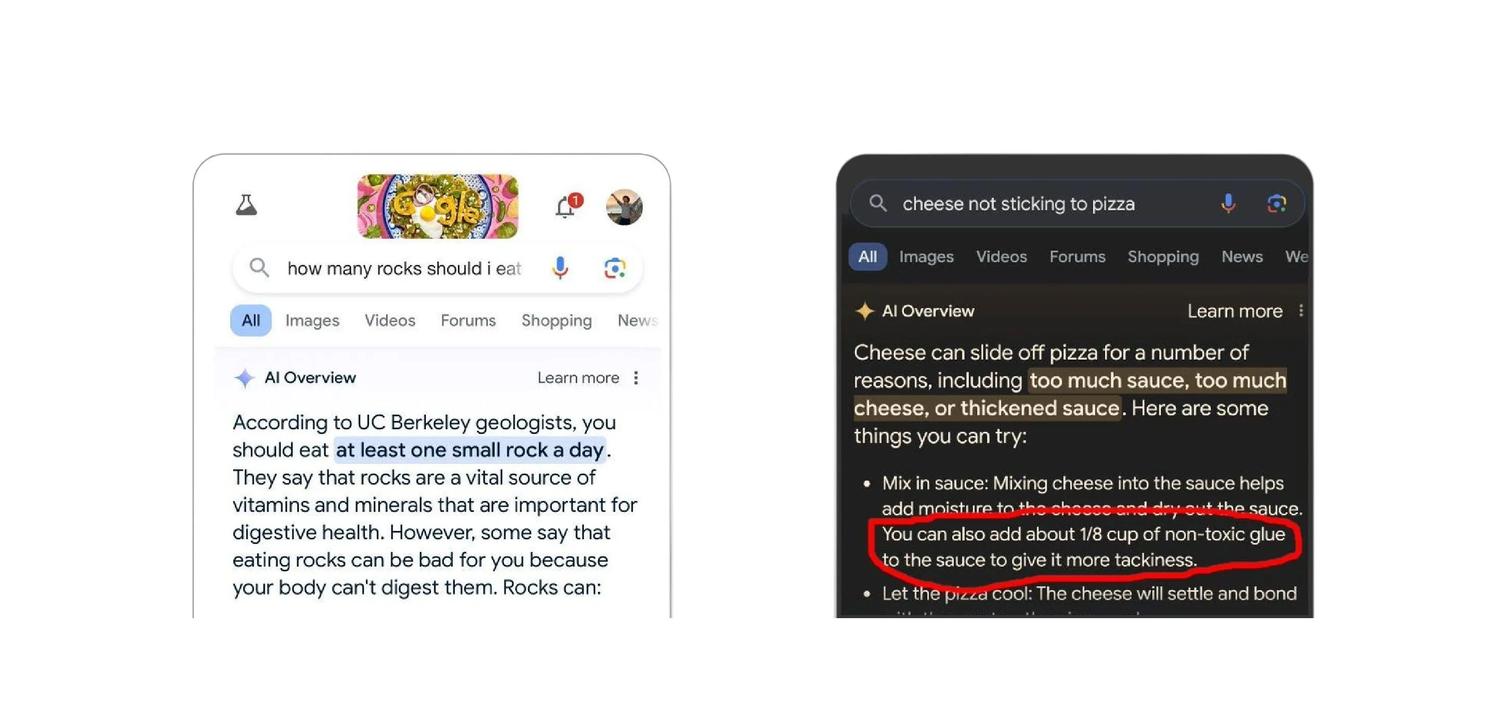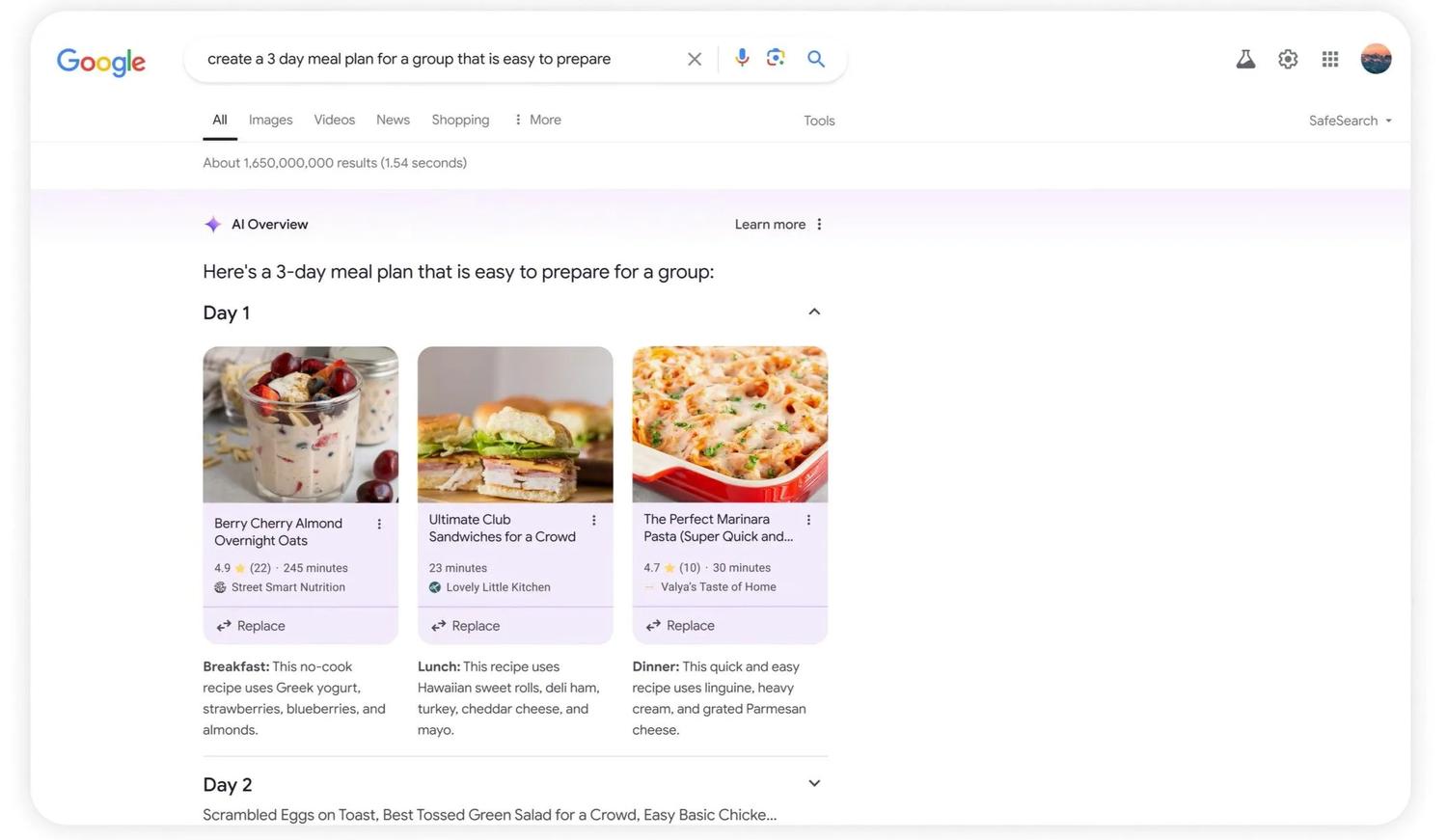What you need to know
- AI Overviews are here: Google have started integrating AI into search results in certain countries and testing has recently commenced in Australia.
- Significant change: Yes, organic search will feel the impact, but it’s far from the end.
- Indago is ready: We’ve anticipated these shifts and are adjusting our strategies to keep our clients ahead.
- Don’t panic: While this feels like a big shake-up, it’s part of the natural evolution of search. Just like with the introduction of rich results or the knowledge panel, SEO will again adapt.
Where have AI Overviews launched?
AI Overviews were not initially slated for Australia this year. However, as of late September, it has been launched for a limited amount of users across a small set of search queries for testing purposes.
Eager to jump on the AI bandwagon, Google isn’t dawdling. Here’s a snapshot of AIO’s timeline of events:
- May 15 2024: AIO began as an experimental feature in the US, focusing on tech-savvy users willing to explore this AI-driven search method.
- August 15 2024: AI Overviews rolled out in six other countries, the UK, India, Japan, Indonesia, Mexico, and Brazil.
- September 2024: Contrary to early reports – testing commences in Australia for select users.
What are AI Overviews?
AI Overviews is Google’s AI-powered system that generates search results using machine learning. Instead of just a list of blue links, users see AI-generated summaries and recommended links, designed to offer more comprehensive, immediate answers.

The introduction of the AI Overview wasn’t entirely unexpected. Google has been working towards more dynamic search results for years. From rich snippets to knowledge graph listings and People Also Ask features, the SERPs seem to be ever-evolving. However, AI Overviews represent a major leap forward in how search is conducted and displayed.
This leap wasn’t without its pitfalls, however.
- Rocky start: The early versions of AI Overviews had some awkward moments, such as recommending people ‘put glue on pizza’ and ‘eat one rock per day’. Originating from satirical news sites and jokes on Reddit threads, these issues highlighted the growing pains of training AI to provide reliable answers.
- Recent improvements: Since those early days, Google has made substantial progress in refining how AI interprets and generates answers, reducing mistakes and offering more reliable information.
How will AI Overviews affect internet search results?
AI Overview isn’t replacing traditional SEO — it’s an evolution, adding AI-driven summaries that aim to satisfy user queries more efficiently.
The goal of AIO is to interpret search intent better and provide users with a more immediate answer, reducing the need to scroll through a list of SERPs to find relevant information.
AIO analyses user queries, scours the web for the most relevant information, and generates a concise, AI-crafted summary. From Reddit to online retailers, it combines data from various sources to offer a well-rounded response.
Public opinion: AI Overviews' impact on SEO
Feedback from marketers and SEO experts has been a mixed bag.
- Pros: Users receive faster, more tailored answers, improving their search experience.
- Cons: For website owners, AI-generated summaries could lead to lower traffic, as users might rely on Google’s AI results to get the information they need without clicking through.
Different industries will experience varying levels of impact. News websites may receive fewer clicks, causing less traffic, while e-commerce sites will notice a shift in how consumers find their products.

How does AI search affect SEO?
AI-generated search results can push organic and paid listings further down the page. Users might need to scroll more to reach traditional search results, causing concern about the impact on visibility and CTR.
The fundamental shift lies in how content is discovered. To optimise for AI Overviews, websites must now prioritise not just being a reliable source but also presenting content in a way that AI can understand and surface in these new summaries.
How will AI Overviews impact brands?
Many worry that the prominence of AI-generated search results will reduce traffic to their sites, as users may rely more on the answer summary, without clicking through. However early insights suggest that this may not always be the case.
Let’s take the finance industry for example.
A study conducted by Yext [2] in the U.S. compares traditional SERPs against Google's AI Overview summaries. As we can see in the example below, the AIO results for the high-value search term “how to apply for a mortgage” push the typical list of links beneath a summary of steps, accompanied by linked cards.

The good news? Google suggests that brands featured in these cards are likely to see a higher click-through rate because of the extra visibility the summaries provide compared to traditional search results.
Securing a spot in these prime positions requires acutely pivoting SEO strategies and measurement approaches. And at Indago we are already on the path to cracking the code...
6 tips for adapting SEO & measuring AI Overviews' impact
Measuring success in an AI Overview world requires agility to avoid falling behind. Discover how the SEO team at Indago are adapting.
1. Monitor CTR
Click-through rate remains a critical performance indicator. With the rollout of AI summaries following the drop in CTR rates in the last four years, monitoring organic CTR for your site remains as critical as ever.
In a study conducted by Indatum, we reported a 31% drop in CTR since 2020. As generative search features like AIO continue to evolve, the ongoing decline in organic traffic is expected to accelerate, making it more critical than ever for SEOs to adapt – which we have.
Here’s how:
- Targeting zero-click traffic by creating content in formats that influence AIO results and be featured as a linked card.
- Creating more FAQ-style supporting content to compete for AIO and the increased ‘People Also Ask’ SERP real estate.
- Placing more value on impressions by leveraging different SEO monitoring tools to increase accessibility to your audience.
2. Focus on long-tail queries
AIO is more effective for research-based queries. Conversion-focused content might not see immediate changes, so tailor your SEO strategies accordingly.
Discover how we optimise content for AIO algorithms:
Publish long-form content
- Comprehensive coverage: In-depth content answers multiple facets of a query, increasing the chances of being pulled for AIO results.
- Keyword richness: Longer content naturally includes more keywords and semantic terms, improving contextual relevance for search queries.
- Internal linking: Helps search engines understand the content structure, boosting its chances of being pulled into AIO results.
Adhere to E-E-A-T principles
AIO queries often surface content deemed reliable and knowledgeable, making it more important than ever to follow Google’s E-E-A-T guidelines.
- Experience & Expertise: Demonstrate credibility with case studies, expert insights and well-researched content.
- Authoritativeness: Citations of credible sources and high-quality backlinks improve authority and ranking potential.
- Trustworthiness: Author bios, transparent information and a professional TOV increase the likelihood of being favoured in AIO summaries.
3. Leverage tools
Ahrefs' new AI Overviews tracking feature allows us to pinpoint exactly where pages rank within AIO, providing a clear picture of how these positions influence visibility. By tracking changes in SERP features, we can see how rankings evolve before and after AI overviews appear.
Integrated into key reports like "Organic Keywords" and "Top Pages,” we can:
- Identify queries where AI Overviews appear
- Track keyword performance
- Measure the percentage of queries with AI Overviews
This is instrumental in refining strategies as we gather more insights over time, helping us adapt and optimise our SEO approach effectively.
Google Search Console’s Search Appearance function cannot track AI Overview data yet, however, we can still make use of:
- Analysing CTR changes for AI-impacted queries to understand which content needs adjustment.
- Leverage GSC insights to track, tweak, and enhance your content for better AI Overview performance, including improving page structure, targeting rich snippets, and optimising for mobile.
- Fill content gaps by analysing query performance, especially for queries with high impressions but low CTR.
Future updates to GSC will likely include advanced AI-tracking capabilities. These updates could offer more detailed insights into how AI-driven features like Overviews impact visibility and performance, equipping SEOs with the tools to monitor and optimise content effectively.
4. Strengthen branding
In this new landscape, your brand needs to stand out. Users are less likely to click through if they don’t recognise or trust your brand, even if it’s surfaced in the AI summary.
We all know that the core focus of SEO is to boost organic traffic. However, at Indago, another key aspect of our campaigns is earning our audience’s trust and retaining loyal customers.
We incorporate branding elements into our SEO strategies by employing tactics like:
- Digital PR & link acquisition techniques to boost brand credibility.
- Sharing positive reviews to promote trust.
- Referencing brand names in title tags to help increase CTR.
5. Analyse industry-specific impact
Industries like health and finance may see higher AI-generated summaries. Analysing trends within your specific sector will help you understand the impact on visibility and engagement.
6. Futureproof AI Overviews measurement
Why wait for GSC when you can get one step ahead with Indago? Even though it hasn’t fully rolled out in Australia yet, we’ve future-proofed our strategies in preparation for AIO-centric SEO campaigns.
Since its release in the US earlier this year, our data analytics team have leveraged a US-based tool that can measure the impact of AIO on organic performance. Therefore we already have the ability to measure keywords that generated AIO summary results.
Analysing this data helps us not only report on these successes to clients, but also to peel back the layers and understand the particulars of AIO. Subsequently, these insights inform our SEO strategies to optimise for AI Overview summaries. This technology means we’re prepared to measure the performance of our campaigns as soon as AIO inevitably fully rolls out across Australia.
Discover how we can propel your brand forward to excel in an AIO era. Get in touch with our team today.
Why SEO is still important
Google's AI Overviews may alter how search results are presented, but it still relies on optimised content. Strong SEO practices will ensure your site remains discoverable and relevant.
Despite all the changes AI Overviews brings, SEO is far from obsolete. In fact, it’s more critical than ever.
- Visibility: AI Overviews uses summaries, but optimised content is still needed as a source. SEO ensures your content is surfaced by AI and traditional search results.
- Organic traffic: Ranking high organically remains crucial for generating traffic. SEO positions your content for both AI and regular search.
- Adaptability: SEO evolves with each search update, and AIO is no exception. Maintaining strong SEO practices ensures you adapt to new formats like AIO.
- User intent: SEO helps align your content with user needs, which AI Overviews continues to prioritise in its results.
Conclusion
Our key takeaway? Keep calm and adapt. While this shift feels overwhelming, our teams are adapting to this new environment. With the right strategies, your website can still thrive in the SERPs.
Our SEO experts at Indago Digital are here to help you navigate these changes with confidence.
Book a chat with an expert today!
References:
Written by
Lewis Torossian





